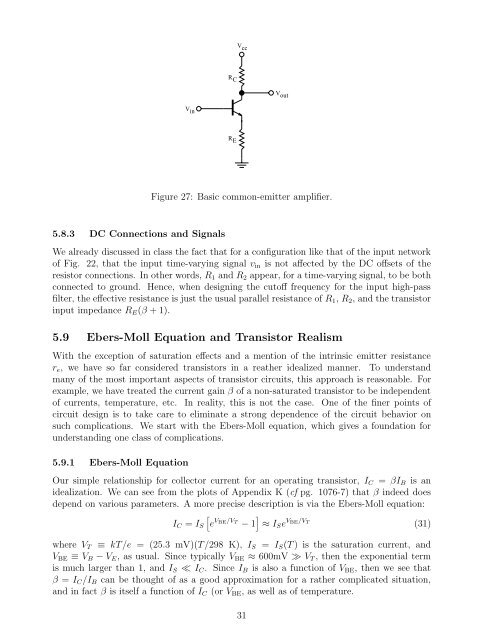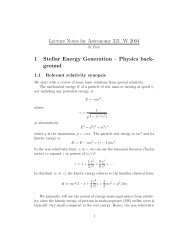Lecture Notes for Analog Electronics - The Electronic Universe ...
Lecture Notes for Analog Electronics - The Electronic Universe ...
Lecture Notes for Analog Electronics - The Electronic Universe ...
You also want an ePaper? Increase the reach of your titles
YUMPU automatically turns print PDFs into web optimized ePapers that Google loves.
V in<br />
5.8.3 DC Connections and Signals<br />
R C<br />
R E<br />
V cc<br />
V out<br />
Figure 27: Basic common-emitter amplifier.<br />
We already discussed in class the fact that <strong>for</strong> a configuration like that of the input network<br />
of Fig. 22, that the input time-varying signal vin is not affected by the DC offsets of the<br />
resistor connections. In other words, R1 and R2 appear, <strong>for</strong> a time-varying signal, to be both<br />
connected to ground. Hence, when designing the cutoff frequency <strong>for</strong> the input high-pass<br />
filter, the effective resistance is just the usual parallel resistance of R1, R2, and the transistor<br />
input impedance RE(β +1).<br />
5.9 Ebers-Moll Equation and Transistor Realism<br />
With the exception of saturation effects and a mention of the intrinsic emitter resistance<br />
re, we have so far considered transistors in a reather idealized manner. To understand<br />
many of the most important aspects of transistor circuits, this approach is reasonable. For<br />
example, we have treated the current gain β of a non-saturated transistor to be independent<br />
of currents, temperature, etc. In reality, this is not the case. One of the finer points of<br />
circuit design is to take care to eliminate a strong dependence of the circuit behavior on<br />
such complications. We start with the Ebers-Moll equation, which gives a foundation <strong>for</strong><br />
understanding one class of complications.<br />
5.9.1 Ebers-Moll Equation<br />
Our simple relationship <strong>for</strong> collector current <strong>for</strong> an operating transistor, IC = βIB is an<br />
idealization. We can see from the plots of Appendix K (cf pg. 1076-7) that β indeed does<br />
depend on various parameters. A more precise description is via the Ebers-Moll equation:<br />
IC = IS<br />
�<br />
e VBE/VT − 1 �<br />
≈ ISe VBE/VT (31)<br />
where VT ≡ kT/e = (25.3 mV)(T/298 K), IS = IS(T ) is the saturation current, and<br />
VBE ≡ VB − VE, as usual. Since typically VBE ≈ 600mV ≫ VT , then the exponential term<br />
is much larger than 1, and IS ≪ IC. Since IBis also a function of VBE, thenweseethat<br />
β=IC/IB can be thought of as a good approximation <strong>for</strong> a rather complicated situation,<br />
and in fact β is itself a function of IC (or VBE, as well as of temperature.<br />
31













